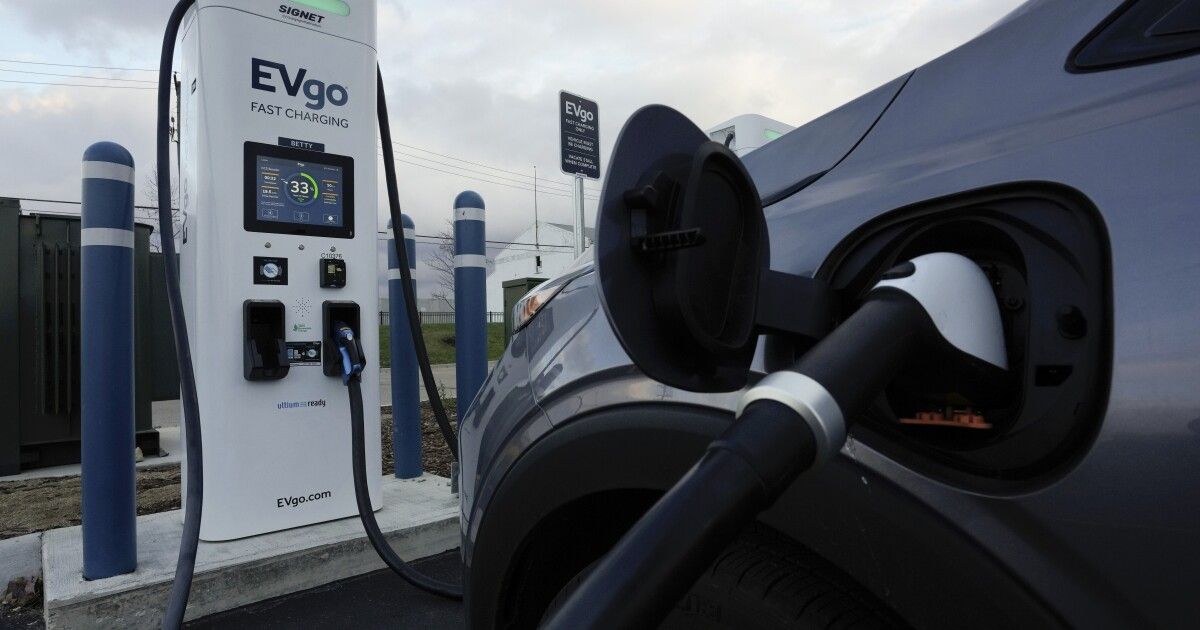Here's how long EVs have to be driven before they save emissions versus gas cars
Electric vehicles must spend a while on the road before they reduce carbon emissions relative to gas-powered cars, an environmental consideration looming over President Joe Biden's push to electrify the vehicle fleet.
That’s because producing an electric vehicle — and manufacturing the battery, in particular — yields a significantly larger carbon footprint compared to producing a traditional, internal combustion engine vehicle.
STICKING POINTS: BIDEN MULLS STUDENT LOANS AND CLIMATE CHANGE IN DEBT CEILING TALKS
It can take years to offset the additional carbon footprint of producing an electric vehicle, though the exact time frame depends on multiple factors, such as miles driven, local power supply, and battery lifespan.
More emissions are created in manufacturing electric vehicles
The manufacture of electric vehicles generates roughly double the amount of greenhouse gas emissions of gas-power vehicles, according to a 2022 joint study from the University of Michigan and Ford Motors.
A 2021 study from Volvo Motors found that the production and manufacturing of its C40 Recharge electric model generates 70% more emissions than its gas vehicle counterpart, the XC40.
In particular, the massive batteries that power electric vehicles are carbon-intensive to make.
That's because the critical minerals used in electric vehicle battery production, such as lithium, cobalt, and nickel, must be mined, smelted, and refined — a process that oftentimes requires the burning of fossil fuels, such as coal or natural gas, to separate the materials. It can also cause the release of harmful particulate matter into the atmosphere.
But electric vehicles generate fewer emissions when they're on the road.
Electric vehicles, once they're on the road, generate less carbon emissions than gas-powered cars. That's because they do not have tailpipe emissions and are more efficient, in energy terms.
Still, running an electric vehicle does entail emissions through the electricity used to charge the car.
“I think consumers should be aware of the fact that, even though there aren't any tailpipe emissions from a battery electric vehicle, there are still emissions to consider in operating the vehicle,” said Max Pyziur, who oversees issues of transportation, natural gas, and electricity at the Energy Policy Research Foundation.
Natural gas, coal, and other carbon-emitting power sources help make up the United States energy mix. If a driver charges a battery on a power grid that is more reliant on coal, for example, that will mean that his electric vehicle saves relatively fewer emissions over time versus a traditional vehicle. On the other hand, if he charges up from a grid that draws exclusively on zero-emissions power sources, such as wind or nuclear, the vehicle will save emissions relatively faster.
In other words, "the quality of the electricity" used to power an electric vehicle is an important consideration, Pyziur said.
Researchers from the Yale School of the Environment appeared to pour cold water on that idea, however.
In a report published in the journal Nature Communications, they sought to measure total indirect emissions from EVs—including from the fuels used to power the grid and thus charge the vehicles. But they found that the EV emissions here still pale in comparison to emissions from fossil-fueled vehicles, researchers said.
“The surprising element was how much lower the emissions of electric vehicles were,” postdoctoral associate Stephanie Weber said in a statement. “The supply chain for combustion vehicles is just so dirty that electric vehicles can’t surpass them, even when you factor in indirect emissions.”
More driving means emissions savings accrue faster
The more ground electric vehicles cover, the more quickly they will save emissions versus a gas-powered car, and the faster they will make up for the emissions generated by battery production and disposal.
Vehicle ownership and driving habits vary greatly by region. Someone in New York City, for example, might only use her car for short trips on the weekends, and rely more on public transportation. For her, it would take more time for net emissions associated with driving an electric vehicle to be lower than they would be for a gas car.
Someone who commuted to work every day and racked up tons of miles in an electric vehicle in Washington State (which generates most of its power from zero-emissions sources) will save emissions much more quickly.
Auke Hoekstra, director of energy transition research at the Eindhoven University of Technology, echoed this view in an interview with the news outlet InsideEVs.
“All studies agree that electric vehicles save between 50 to 70% CO2 equivalents and that the time needed to recoup the additional emissions caused by battery production is one to two years,” he said.
“The more you drive, the faster you’ll recoup," he added.
Adding it all up
Although the exact emissions savings from electric vehicles will depend on all the variables mentioned above, some researchers have tried to provide averages across the range of possibilities.
The University of Michigan/Ford study found that it took 1.4-1.5 years on the road for electric sedans to save emissions versus traditional sedans. The corresponding numbers were 1.6-1.9 years for electric SUVs and 1.6 years for electric pickup trucks, based on the average number of U.S. vehicle miles traveled.
The Volvo study found that, in a scenario in which its power source is the current global energy mix, the C40 Recharge EV would need to cover 68,300 miles to break even with its gas-power equivalent — or almost six years, based on U.S. average miles traveled a year, roughly half its lifetime.
But that breakeven point would fall to about four years if the car was charged on the European Union's grid, which is cleaner. In a scenario in which the car was charged on a grid powered exclusively by renewable sources, the breakeven point would be about two and a half years.
Or, to take another example: A Tesla Model 3 would have to be driven for 13,500 miles before it saved emissions versus a gas Toyota Corolla in the U.S., a little over a year's worth of driving, according to a Reuters analysis using a model developed by the Argonne National Laboratory in Illinois.
In Norway, which has a cleaner grid, the Tesla would save emissions versus the Corolla in under a year.
Total “cradle to grave” emissions
Typically, cars and trucks stay on the road for much longer than one to two years, as they're used, resold, and generally only scrapped when they're badly outdated or no longer working.
The average lifespan of a gas vehicle is around 10 years, or 200,000 miles.
Meanwhile, EV batteries in the U.S. can last around 10-20 years, though factors such as living in a hotter climate or frequently using direct current rapid charging can reduce their lifespan, according to a 2022 report from J.D. Power. (Some car companies offer warranties for EV batteries, often around 8-10 years.)
Experts think about car emissions on a “cradle to grave” basis — that is, how many emissions are associated with the manufacturing of the car, the energy used to drive it, the emissions generated while it's on the road, its disposal, and everything else involved in its use.
CLICK HERE TO READ MORE FROM THE WASHINGTON EXAMINER
For sedans, SUVs, and pickup trucks, the University of Michigan study found battery vehicles generate 64% lower greenhouse gas emissions than internal combustion engine vehicles in the U.S.
Swapping out a gas-powered sedan for an electric model saves a total of 45 metric tons of carbon dioxide equivalent over the lifetime of the vehicle. Switching from a gas-powered SUV to a battery-powered model saves 56 metric tons of carbon dioxide equivalent, while doing so with a pickup truck will save 74 metric tons of carbon dioxide equivalent.
Source: Washington Examiner


